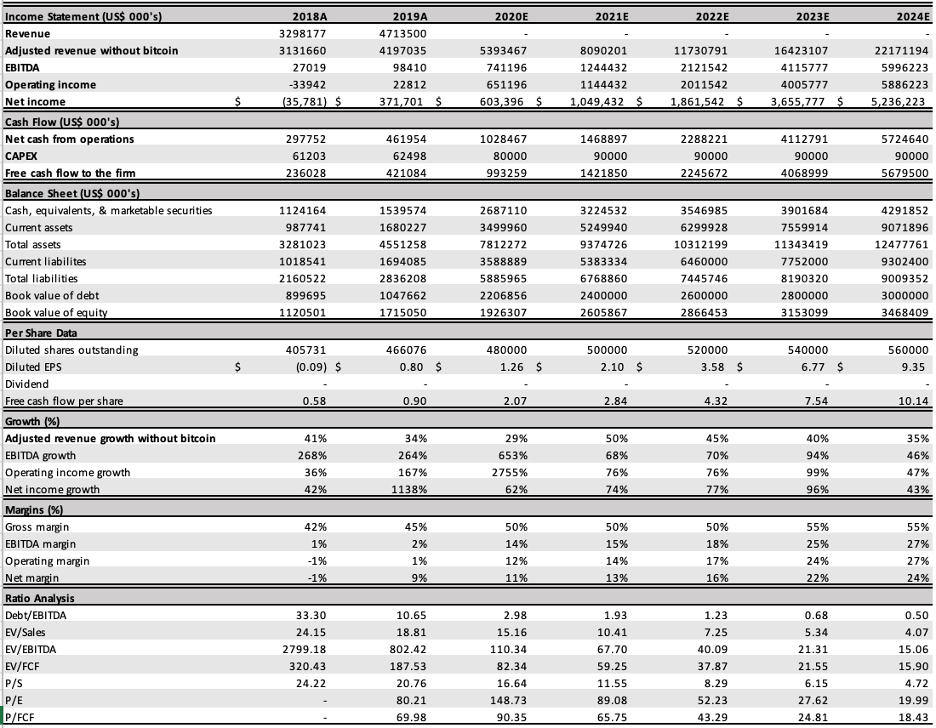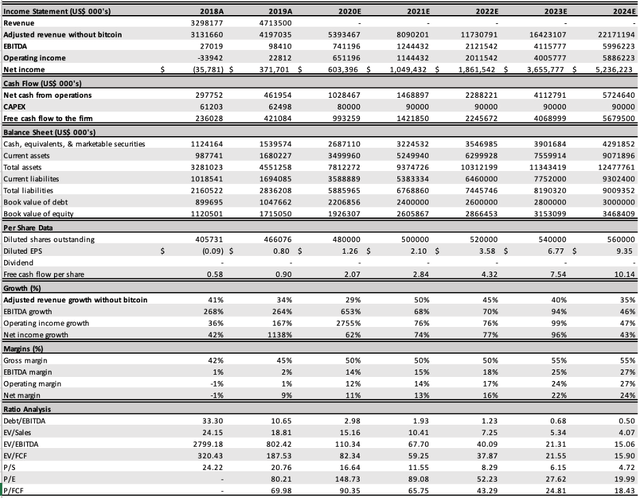Summary
Square (SQ) is a good company with a recognizable brand. They offer a diversified list of products and services in the financial services industry. The problem is they face very strong competition from new entrants as well as industry heavyweights which will put pressure on future prospects. Even after assuming generous growth and margin expansion, SQ is extremely overvalued. I have a 12-month price target of $79.65.
Overview
SQ is a financial services company that provides mobile payment processing and point of sale solutions for small to medium size businesses. They provide eCommerce tools to help businesses build an online presence. Additionally, individuals can use SQs Cash App for peer-to-peer payments, direct deposits, brokerage services, bitcoin investing, and as a Cash Card for spending. They have been approved by regulator to open a bank, which they plan to do in 2021.
Investment Thesis
SQ was founded in 2009 as a mobile payment processor. Since going public in 2015 it has struggled to become profitable. 2019 was its first year without a loss, but that was due to the sale of its food ordering business Caviar. The company is experiencing slowing revenue growth and tight margins, making the path to profitability unclear. In fact, a closer look at their last quarterly statement shows that year over year revenues were flat after adjusting for bitcoin. I believe it is prudent to remove bitcoin revenues and costs from all calculations, since they provide no value and actually increase risk. While some of the slowdown in revenue growth can be attributed to COVID-19, this growth was already trending downwards, and the epidemic has actually helped the strong Cash App growth. Even after accounting for a large bounce back in its Seller ecosystem growth, the company is extremely overvalued by most metrics.
Catalysts
The main driver of a share price pullback in SQ are its fundamentals. Investors are currently pricing in exponential growth and increasing margins, but an analysis of its financial statements and a comparison to competitors shows that these expectations are unrealistic. Additionally, more competition is entering the space which will provide further pressure on their future growth.
Valuation
SQ is currently being valued like a high growth tech company but lacks the fundamentals to achieve this valuation. Its growth has slowed, and it has not achieved improving margins with scale. In the last few years, operating costs have grown in tandem with revenues leaving operating margins flat.
My DCF analysis uses a WACC of 12.6% as the discount rate, and the current risk-free rate of 0.698% as the terminal growth rate. The analysis uses adjusted numbers, removing bitcoin revenues and costs from when they first appear in the financials in 2018, through all my projections. From 2018 to 2019 adjusted revenue growth slowed from 41% to 34%. An analysis of their most recent 10-Q shows as of June 30, 2020, 3-month ended year-over-year revenue growth declined 0.1%. The 6-month ended year over year revenue growth was 9.27%. Again, these are all adjusted for bitcoin. Obviously COVID-19 played a big role in the Q2 slowdown, so I have accounted for this by applying a generous 30% revenue growth rate for Q3 and 40% for Q4, implying a strong bounce back as businesses slowly reopen. These expectations have to be tempered by the fact that some of these small and medium sized businesses are never coming back.
I continue my optimistic projections as the move to a cashless society is accelerated, providing continued growth for the Cash App ecosystem. As more businesses are drawn to SQs Seller ecosystem, both of its segments experience strong growth. From 2021-2024, revenue growth rates are 50%, 45%, %40, and 35%. I also assume that as the company grows, it benefits from improving margins due to scale and network effects. These are generous assumptions considering they haven’t been able to accomplish this yet. Their operating margins improve gradually from 1% in 2019 to 27% in 2024. Their profit margins improve from 9% in 2019 to 24% in 2024. It’s important to note that profit margins were -1% in 2018, and the jump in 2019 should be attributed to the sale of their food ordering business Caviar.
Even after assuming strong growth and improving margins, my forecast shows SQ trading at rich multiples. With my projections, its 2021 multiples are a P/S of 11.55, P/E of 89.08, and P/FCF of 65.75. Its EV multiples project to be an EV/S of 10.41, EV/EBITDA of 67.70, and EV/FCF of 59.25. Comparing these multiples to competitors helps illustrate the issues with the current valuation. SQ provides multiple services so no single comparison will be exact. However, we can look at all the comparisons and then get an overall view.
Source: Company data, EDGAR database, author estimates
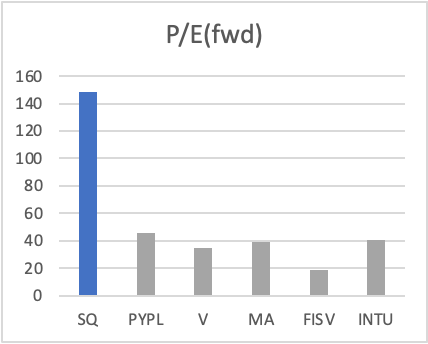
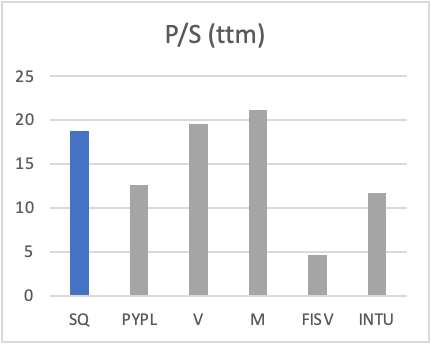
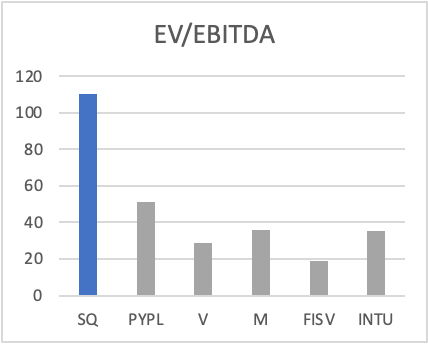
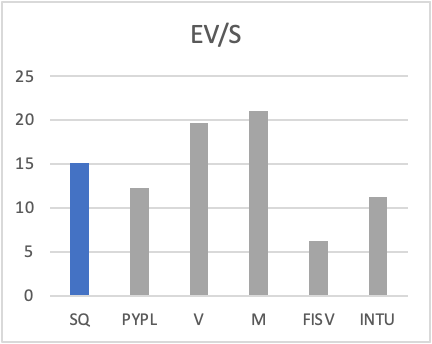
Source: All charts made using Yahoo Finance, Excel, and author estimates.
As the charts illustrate, SQs P/E and EV/EBITDA multiples greatly exceed their competitors. For P/S and EV/S, only the two financial giants Visa(V) and Mastercard (MA) have more stretched multiples.
Competition
SQ already faces competition in all of its lines of business, and more competitors are entering. Current competitors include Paypal (PYPL), Fiserv (FISV), Stripe, Visa, and Mastercard to name a few. Additionally, more competition is entering the space which will provide further pressure on their bottom line. JP Morgan (JPM) has introduced its new QuickAccept service that allows businesses to take card payments through a mobile app or contactless card reader. Unlike SQ, users will see the funds in their accounts the same day for free. SQ takes at least a day or charges a fee of 1.5% to make the transfer instant. Visa is expanding its tap to phone for contactless transactions, allowing merchants to turn their Android devices into POS terminals. PayPal is allowing customers to buy and sell cryptocurrency directly from their accounts. They plan to make crypto available as a source of funding for purchases at their merchants. All of this competition is going to put pressure on SQs growth and margins.
Risks
My DCF model uses many assumptions to come to a valuation and there is always a risk that the estimates are wrong. If revenue growth and margin expansion are stronger than my estimates, the actual share price could be much higher than my target.
It’s also possible that I have undervalued the network effects of the entire SQ ecosystem. If more businesses and individuals are drawn to the diversity of SQs offerings, this could have a positive impact on the business.
I may be underestimating the effects of SQs bank on their business and future growth. That being said, I must factor in the increased regulatory scrutiny, capital requirements, and risks that come with being a bank.
Conclusion
Square is a good company in a growing space but its share price has gotten way ahead of its fundamentals. Competition is strong and only getting started. I see a lot of downside risk ending in a greater than 50% price drop.
Disclosure: I am/we are short SQ. I wrote this article myself, and it expresses my own opinions. I am not receiving compensation for it. I have no business relationship with any company whose stock is mentioned in this article.
